INF80025 Business Info Systems: Comparing Analysis Methodologies
VerifiedAdded on 2023/06/11
|12
|3332
|437
Report
AI Summary
This report provides a critical evaluation of business information systems, focusing on the application of hard and soft methodologies like SSM, ETHICS, and OOAD within an organizational context. It discusses the socio-technical toolbox and its themes—system change analysis, structure definition, purpose, perspectives, priorities, desirable system, action, and evaluation. The report further explores hard and soft systems thinking, highlighting the challenges in defining problems within soft systems. It emphasizes the relationship between these methodologies and the types of problems they address, particularly the role of SSM in solving complex, soft-thinking-related issues. The analysis considers the impact of a changing business environment and the importance of aligning methodologies with organizational needs, using healthcare as an example, and IT's role in business process improvement. Access more solved assignments and study tools on Desklib.
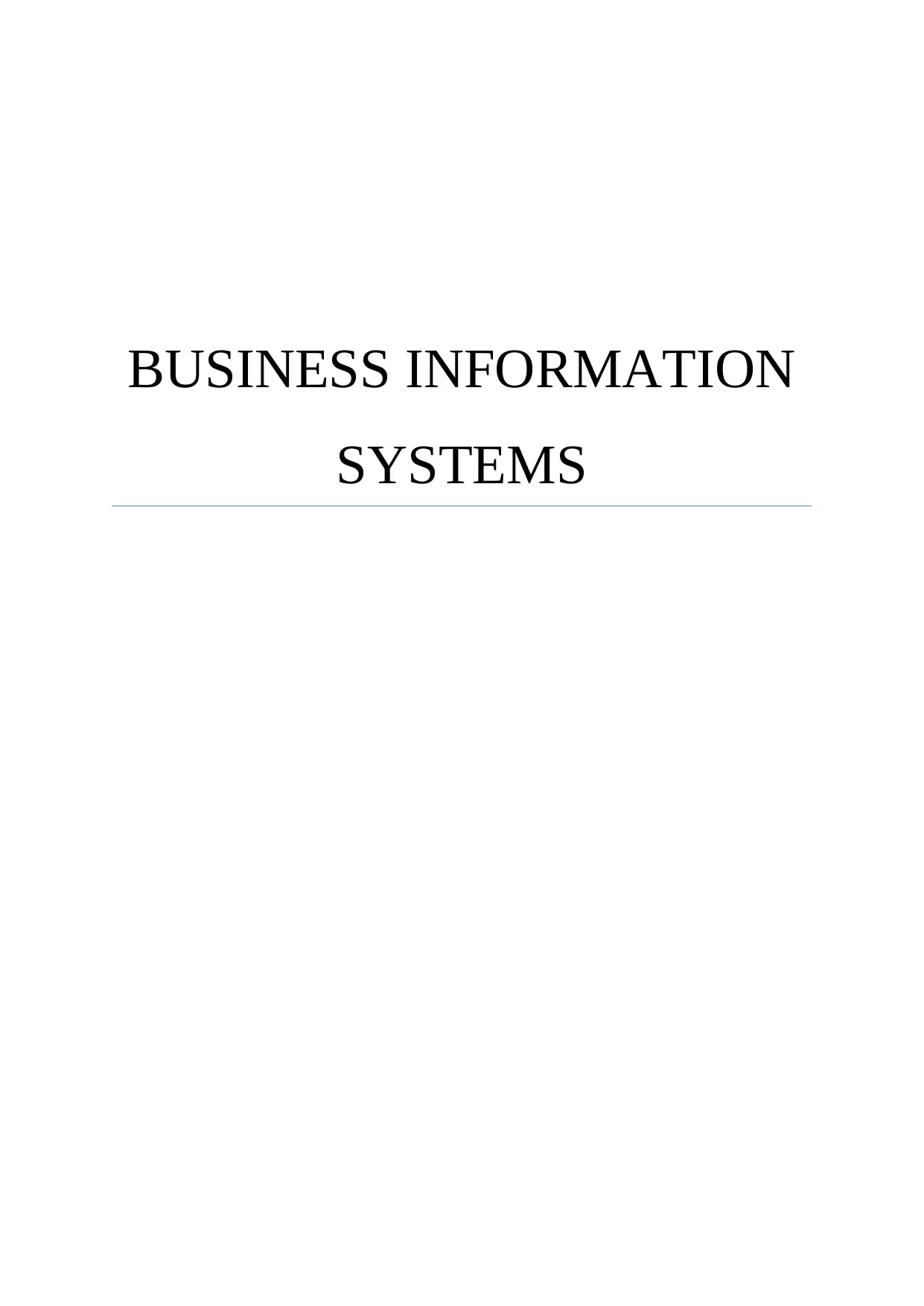
BUSINESS INFORMATION
SYSTEMS
SYSTEMS
Paraphrase This Document
Need a fresh take? Get an instant paraphrase of this document with our AI Paraphraser
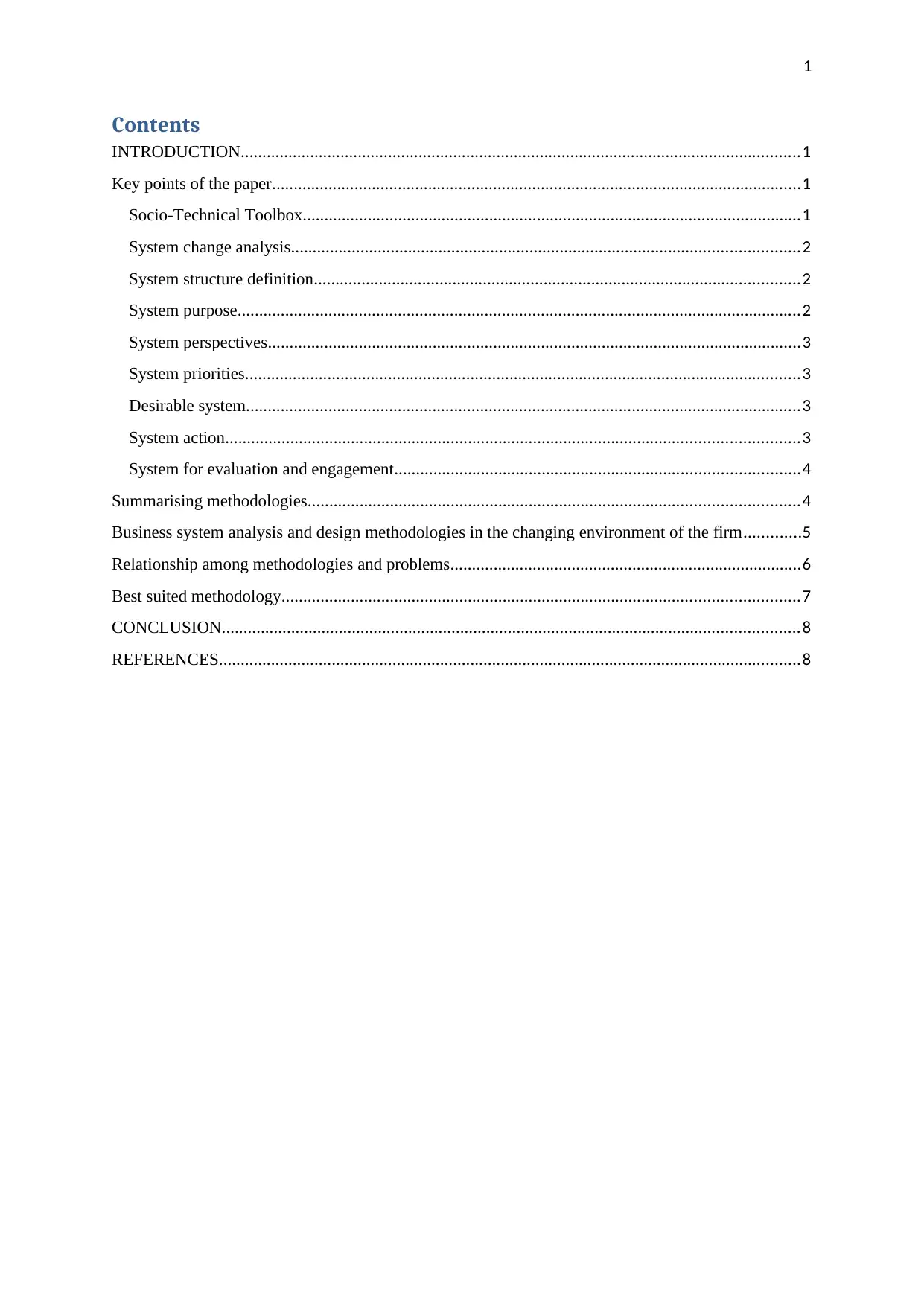
1
Contents
INTRODUCTION.................................................................................................................................1
Key points of the paper..........................................................................................................................1
Socio-Technical Toolbox...................................................................................................................1
System change analysis.....................................................................................................................2
System structure definition................................................................................................................2
System purpose..................................................................................................................................2
System perspectives...........................................................................................................................3
System priorities................................................................................................................................3
Desirable system................................................................................................................................3
System action....................................................................................................................................3
System for evaluation and engagement.............................................................................................4
Summarising methodologies.................................................................................................................4
Business system analysis and design methodologies in the changing environment of the firm.............5
Relationship among methodologies and problems.................................................................................6
Best suited methodology.......................................................................................................................7
CONCLUSION.....................................................................................................................................8
REFERENCES......................................................................................................................................8
Contents
INTRODUCTION.................................................................................................................................1
Key points of the paper..........................................................................................................................1
Socio-Technical Toolbox...................................................................................................................1
System change analysis.....................................................................................................................2
System structure definition................................................................................................................2
System purpose..................................................................................................................................2
System perspectives...........................................................................................................................3
System priorities................................................................................................................................3
Desirable system................................................................................................................................3
System action....................................................................................................................................3
System for evaluation and engagement.............................................................................................4
Summarising methodologies.................................................................................................................4
Business system analysis and design methodologies in the changing environment of the firm.............5
Relationship among methodologies and problems.................................................................................6
Best suited methodology.......................................................................................................................7
CONCLUSION.....................................................................................................................................8
REFERENCES......................................................................................................................................8
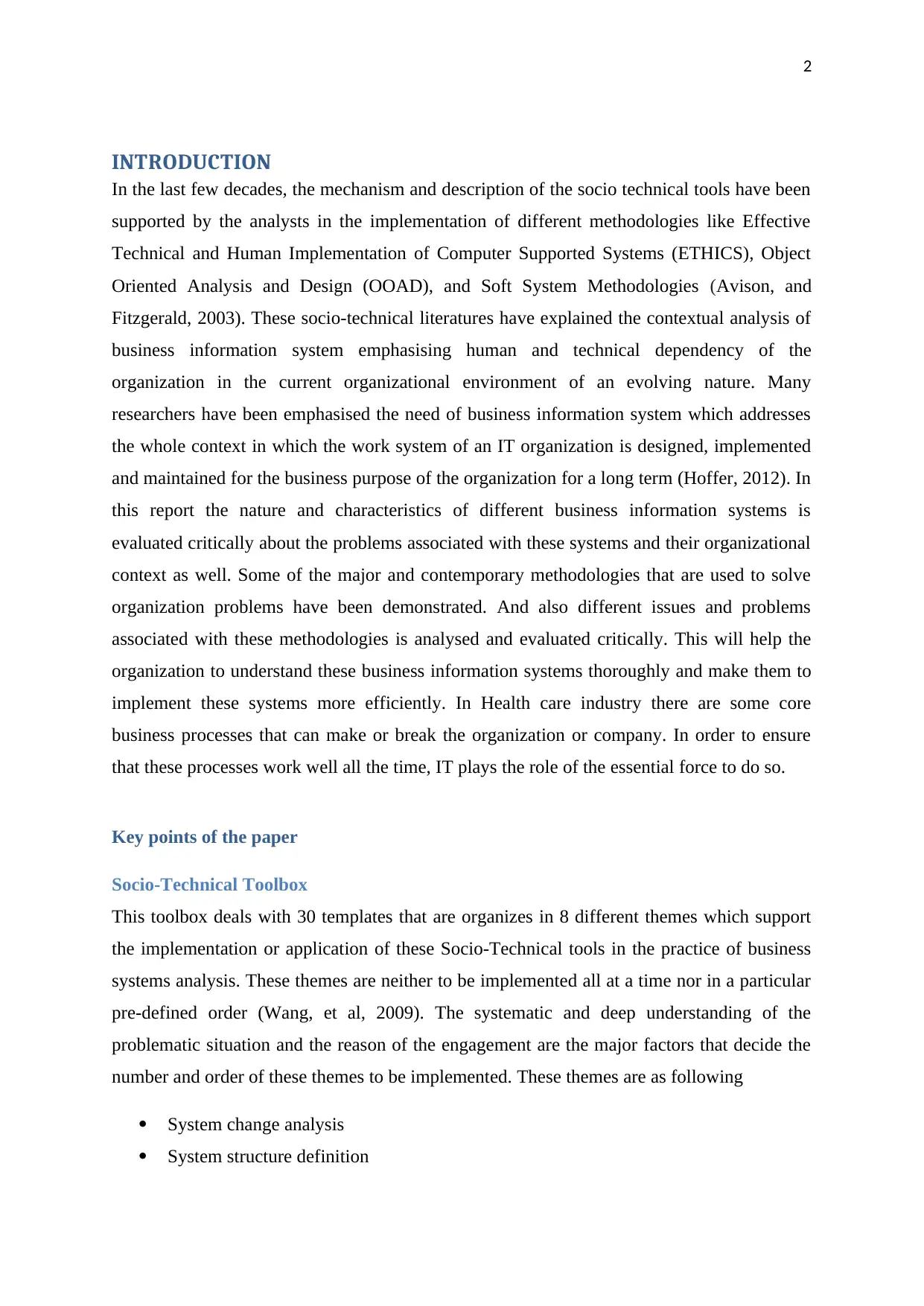
2
INTRODUCTION
In the last few decades, the mechanism and description of the socio technical tools have been
supported by the analysts in the implementation of different methodologies like Effective
Technical and Human Implementation of Computer Supported Systems (ETHICS), Object
Oriented Analysis and Design (OOAD), and Soft System Methodologies (Avison, and
Fitzgerald, 2003). These socio-technical literatures have explained the contextual analysis of
business information system emphasising human and technical dependency of the
organization in the current organizational environment of an evolving nature. Many
researchers have been emphasised the need of business information system which addresses
the whole context in which the work system of an IT organization is designed, implemented
and maintained for the business purpose of the organization for a long term (Hoffer, 2012). In
this report the nature and characteristics of different business information systems is
evaluated critically about the problems associated with these systems and their organizational
context as well. Some of the major and contemporary methodologies that are used to solve
organization problems have been demonstrated. And also different issues and problems
associated with these methodologies is analysed and evaluated critically. This will help the
organization to understand these business information systems thoroughly and make them to
implement these systems more efficiently. In Health care industry there are some core
business processes that can make or break the organization or company. In order to ensure
that these processes work well all the time, IT plays the role of the essential force to do so.
Key points of the paper
Socio-Technical Toolbox
This toolbox deals with 30 templates that are organizes in 8 different themes which support
the implementation or application of these Socio-Technical tools in the practice of business
systems analysis. These themes are neither to be implemented all at a time nor in a particular
pre-defined order (Wang, et al, 2009). The systematic and deep understanding of the
problematic situation and the reason of the engagement are the major factors that decide the
number and order of these themes to be implemented. These themes are as following
System change analysis
System structure definition
INTRODUCTION
In the last few decades, the mechanism and description of the socio technical tools have been
supported by the analysts in the implementation of different methodologies like Effective
Technical and Human Implementation of Computer Supported Systems (ETHICS), Object
Oriented Analysis and Design (OOAD), and Soft System Methodologies (Avison, and
Fitzgerald, 2003). These socio-technical literatures have explained the contextual analysis of
business information system emphasising human and technical dependency of the
organization in the current organizational environment of an evolving nature. Many
researchers have been emphasised the need of business information system which addresses
the whole context in which the work system of an IT organization is designed, implemented
and maintained for the business purpose of the organization for a long term (Hoffer, 2012). In
this report the nature and characteristics of different business information systems is
evaluated critically about the problems associated with these systems and their organizational
context as well. Some of the major and contemporary methodologies that are used to solve
organization problems have been demonstrated. And also different issues and problems
associated with these methodologies is analysed and evaluated critically. This will help the
organization to understand these business information systems thoroughly and make them to
implement these systems more efficiently. In Health care industry there are some core
business processes that can make or break the organization or company. In order to ensure
that these processes work well all the time, IT plays the role of the essential force to do so.
Key points of the paper
Socio-Technical Toolbox
This toolbox deals with 30 templates that are organizes in 8 different themes which support
the implementation or application of these Socio-Technical tools in the practice of business
systems analysis. These themes are neither to be implemented all at a time nor in a particular
pre-defined order (Wang, et al, 2009). The systematic and deep understanding of the
problematic situation and the reason of the engagement are the major factors that decide the
number and order of these themes to be implemented. These themes are as following
System change analysis
System structure definition
⊘ This is a preview!⊘
Do you want full access?
Subscribe today to unlock all pages.

Trusted by 1+ million students worldwide
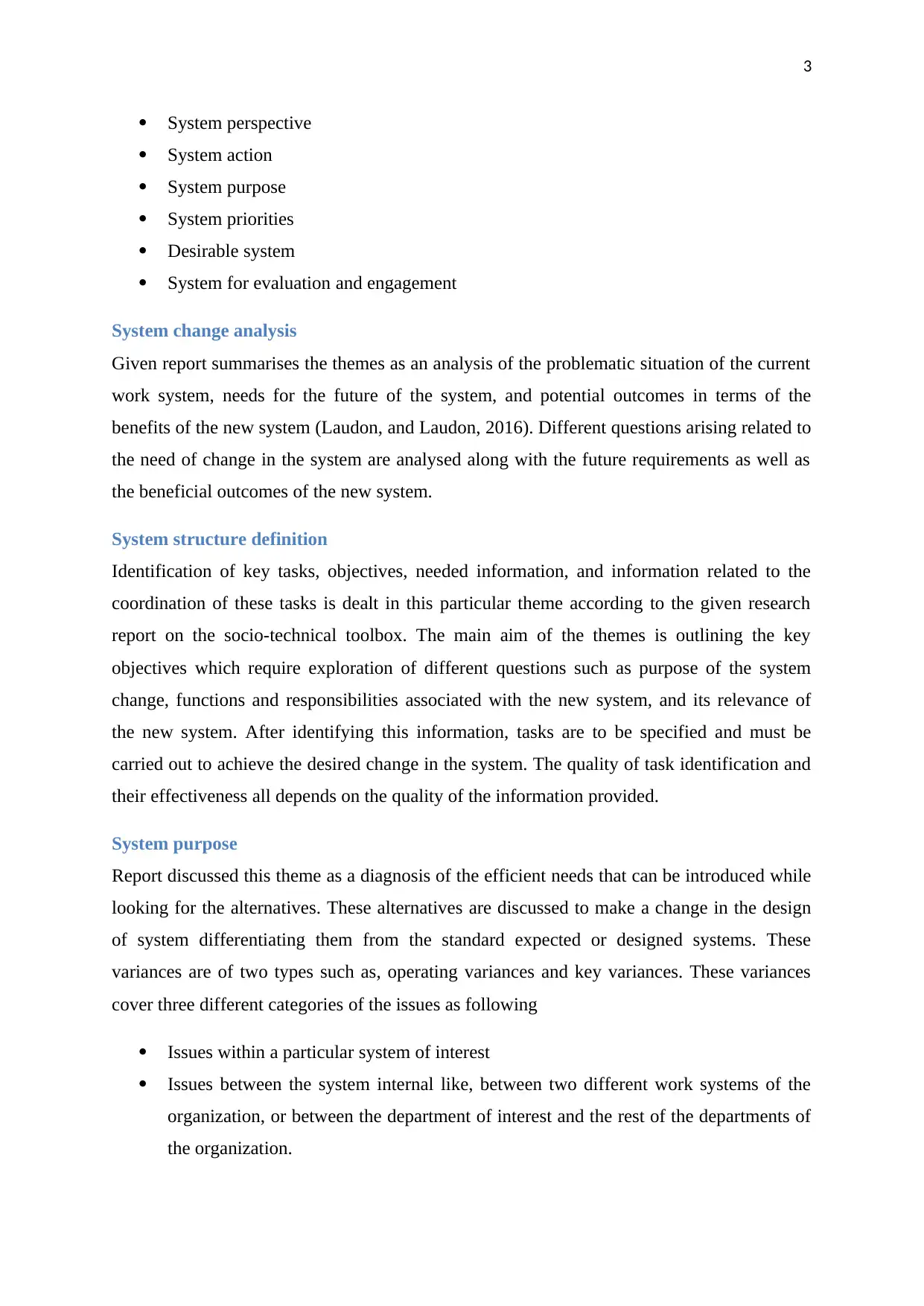
3
System perspective
System action
System purpose
System priorities
Desirable system
System for evaluation and engagement
System change analysis
Given report summarises the themes as an analysis of the problematic situation of the current
work system, needs for the future of the system, and potential outcomes in terms of the
benefits of the new system (Laudon, and Laudon, 2016). Different questions arising related to
the need of change in the system are analysed along with the future requirements as well as
the beneficial outcomes of the new system.
System structure definition
Identification of key tasks, objectives, needed information, and information related to the
coordination of these tasks is dealt in this particular theme according to the given research
report on the socio-technical toolbox. The main aim of the themes is outlining the key
objectives which require exploration of different questions such as purpose of the system
change, functions and responsibilities associated with the new system, and its relevance of
the new system. After identifying this information, tasks are to be specified and must be
carried out to achieve the desired change in the system. The quality of task identification and
their effectiveness all depends on the quality of the information provided.
System purpose
Report discussed this theme as a diagnosis of the efficient needs that can be introduced while
looking for the alternatives. These alternatives are discussed to make a change in the design
of system differentiating them from the standard expected or designed systems. These
variances are of two types such as, operating variances and key variances. These variances
cover three different categories of the issues as following
Issues within a particular system of interest
Issues between the system internal like, between two different work systems of the
organization, or between the department of interest and the rest of the departments of
the organization.
System perspective
System action
System purpose
System priorities
Desirable system
System for evaluation and engagement
System change analysis
Given report summarises the themes as an analysis of the problematic situation of the current
work system, needs for the future of the system, and potential outcomes in terms of the
benefits of the new system (Laudon, and Laudon, 2016). Different questions arising related to
the need of change in the system are analysed along with the future requirements as well as
the beneficial outcomes of the new system.
System structure definition
Identification of key tasks, objectives, needed information, and information related to the
coordination of these tasks is dealt in this particular theme according to the given research
report on the socio-technical toolbox. The main aim of the themes is outlining the key
objectives which require exploration of different questions such as purpose of the system
change, functions and responsibilities associated with the new system, and its relevance of
the new system. After identifying this information, tasks are to be specified and must be
carried out to achieve the desired change in the system. The quality of task identification and
their effectiveness all depends on the quality of the information provided.
System purpose
Report discussed this theme as a diagnosis of the efficient needs that can be introduced while
looking for the alternatives. These alternatives are discussed to make a change in the design
of system differentiating them from the standard expected or designed systems. These
variances are of two types such as, operating variances and key variances. These variances
cover three different categories of the issues as following
Issues within a particular system of interest
Issues between the system internal like, between two different work systems of the
organization, or between the department of interest and the rest of the departments of
the organization.
Paraphrase This Document
Need a fresh take? Get an instant paraphrase of this document with our AI Paraphraser
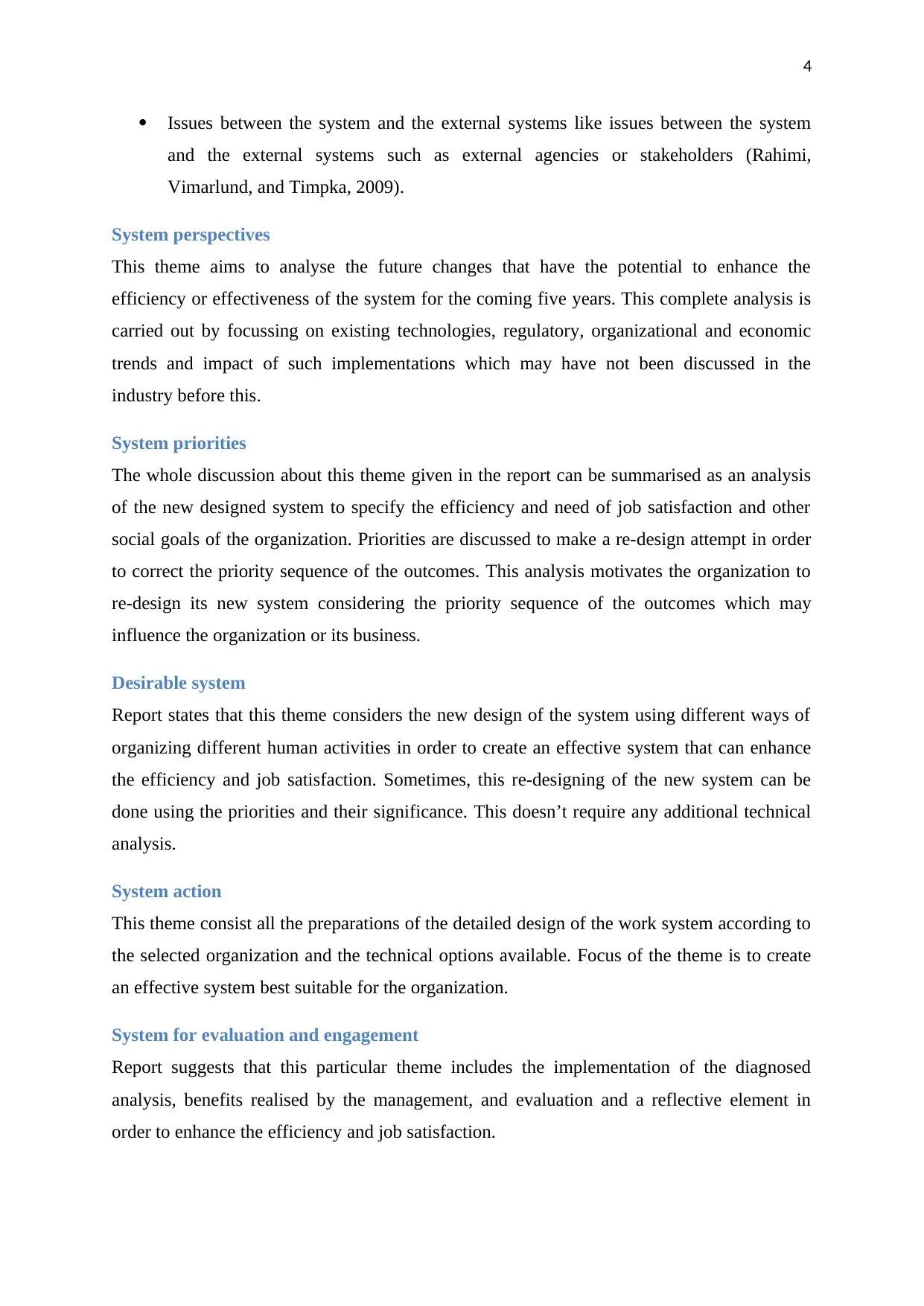
4
Issues between the system and the external systems like issues between the system
and the external systems such as external agencies or stakeholders (Rahimi,
Vimarlund, and Timpka, 2009).
System perspectives
This theme aims to analyse the future changes that have the potential to enhance the
efficiency or effectiveness of the system for the coming five years. This complete analysis is
carried out by focussing on existing technologies, regulatory, organizational and economic
trends and impact of such implementations which may have not been discussed in the
industry before this.
System priorities
The whole discussion about this theme given in the report can be summarised as an analysis
of the new designed system to specify the efficiency and need of job satisfaction and other
social goals of the organization. Priorities are discussed to make a re-design attempt in order
to correct the priority sequence of the outcomes. This analysis motivates the organization to
re-design its new system considering the priority sequence of the outcomes which may
influence the organization or its business.
Desirable system
Report states that this theme considers the new design of the system using different ways of
organizing different human activities in order to create an effective system that can enhance
the efficiency and job satisfaction. Sometimes, this re-designing of the new system can be
done using the priorities and their significance. This doesn’t require any additional technical
analysis.
System action
This theme consist all the preparations of the detailed design of the work system according to
the selected organization and the technical options available. Focus of the theme is to create
an effective system best suitable for the organization.
System for evaluation and engagement
Report suggests that this particular theme includes the implementation of the diagnosed
analysis, benefits realised by the management, and evaluation and a reflective element in
order to enhance the efficiency and job satisfaction.
Issues between the system and the external systems like issues between the system
and the external systems such as external agencies or stakeholders (Rahimi,
Vimarlund, and Timpka, 2009).
System perspectives
This theme aims to analyse the future changes that have the potential to enhance the
efficiency or effectiveness of the system for the coming five years. This complete analysis is
carried out by focussing on existing technologies, regulatory, organizational and economic
trends and impact of such implementations which may have not been discussed in the
industry before this.
System priorities
The whole discussion about this theme given in the report can be summarised as an analysis
of the new designed system to specify the efficiency and need of job satisfaction and other
social goals of the organization. Priorities are discussed to make a re-design attempt in order
to correct the priority sequence of the outcomes. This analysis motivates the organization to
re-design its new system considering the priority sequence of the outcomes which may
influence the organization or its business.
Desirable system
Report states that this theme considers the new design of the system using different ways of
organizing different human activities in order to create an effective system that can enhance
the efficiency and job satisfaction. Sometimes, this re-designing of the new system can be
done using the priorities and their significance. This doesn’t require any additional technical
analysis.
System action
This theme consist all the preparations of the detailed design of the work system according to
the selected organization and the technical options available. Focus of the theme is to create
an effective system best suitable for the organization.
System for evaluation and engagement
Report suggests that this particular theme includes the implementation of the diagnosed
analysis, benefits realised by the management, and evaluation and a reflective element in
order to enhance the efficiency and job satisfaction.
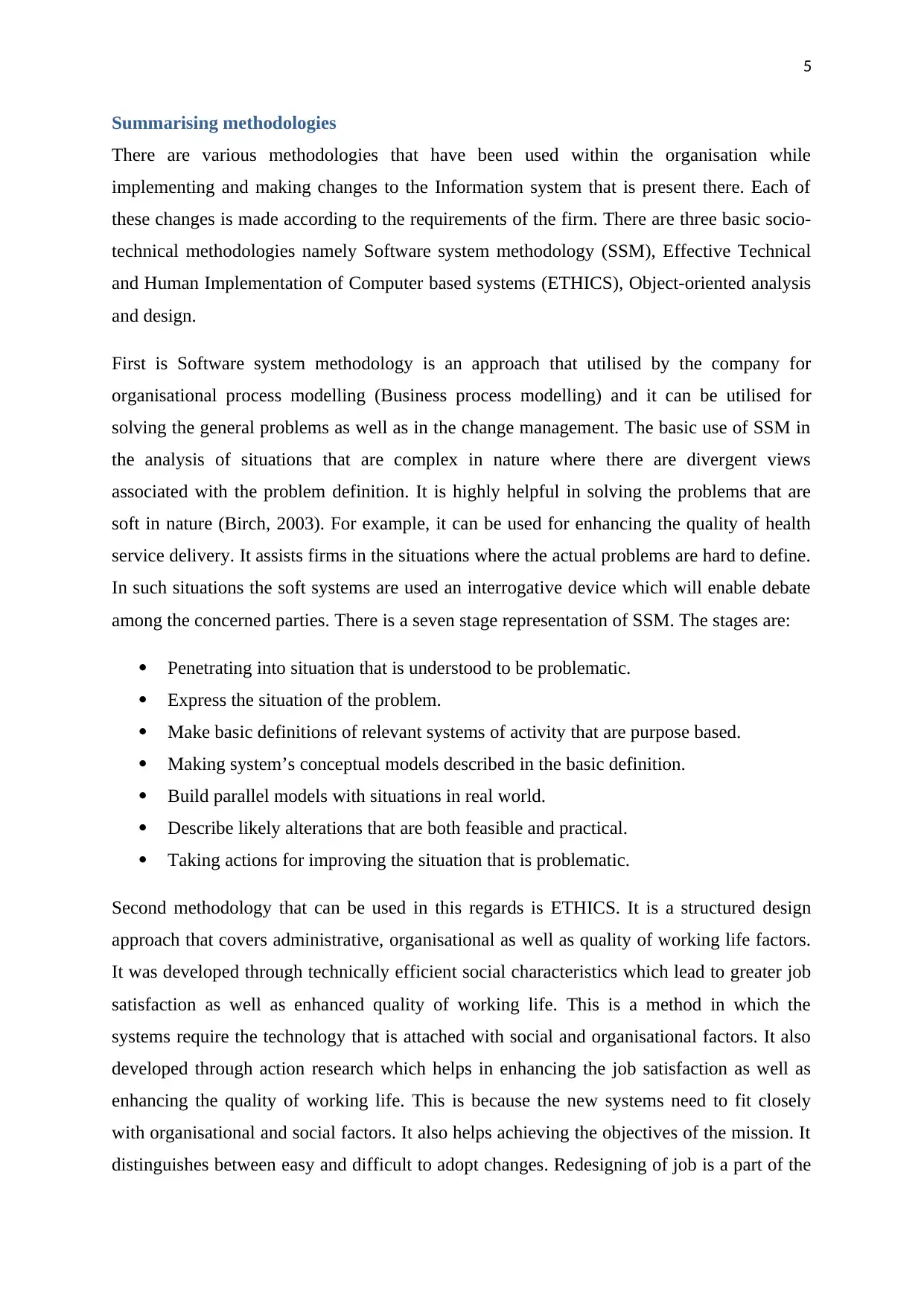
5
Summarising methodologies
There are various methodologies that have been used within the organisation while
implementing and making changes to the Information system that is present there. Each of
these changes is made according to the requirements of the firm. There are three basic socio-
technical methodologies namely Software system methodology (SSM), Effective Technical
and Human Implementation of Computer based systems (ETHICS), Object-oriented analysis
and design.
First is Software system methodology is an approach that utilised by the company for
organisational process modelling (Business process modelling) and it can be utilised for
solving the general problems as well as in the change management. The basic use of SSM in
the analysis of situations that are complex in nature where there are divergent views
associated with the problem definition. It is highly helpful in solving the problems that are
soft in nature (Birch, 2003). For example, it can be used for enhancing the quality of health
service delivery. It assists firms in the situations where the actual problems are hard to define.
In such situations the soft systems are used an interrogative device which will enable debate
among the concerned parties. There is a seven stage representation of SSM. The stages are:
Penetrating into situation that is understood to be problematic.
Express the situation of the problem.
Make basic definitions of relevant systems of activity that are purpose based.
Making system’s conceptual models described in the basic definition.
Build parallel models with situations in real world.
Describe likely alterations that are both feasible and practical.
Taking actions for improving the situation that is problematic.
Second methodology that can be used in this regards is ETHICS. It is a structured design
approach that covers administrative, organisational as well as quality of working life factors.
It was developed through technically efficient social characteristics which lead to greater job
satisfaction as well as enhanced quality of working life. This is a method in which the
systems require the technology that is attached with social and organisational factors. It also
developed through action research which helps in enhancing the job satisfaction as well as
enhancing the quality of working life. This is because the new systems need to fit closely
with organisational and social factors. It also helps achieving the objectives of the mission. It
distinguishes between easy and difficult to adopt changes. Redesigning of job is a part of the
Summarising methodologies
There are various methodologies that have been used within the organisation while
implementing and making changes to the Information system that is present there. Each of
these changes is made according to the requirements of the firm. There are three basic socio-
technical methodologies namely Software system methodology (SSM), Effective Technical
and Human Implementation of Computer based systems (ETHICS), Object-oriented analysis
and design.
First is Software system methodology is an approach that utilised by the company for
organisational process modelling (Business process modelling) and it can be utilised for
solving the general problems as well as in the change management. The basic use of SSM in
the analysis of situations that are complex in nature where there are divergent views
associated with the problem definition. It is highly helpful in solving the problems that are
soft in nature (Birch, 2003). For example, it can be used for enhancing the quality of health
service delivery. It assists firms in the situations where the actual problems are hard to define.
In such situations the soft systems are used an interrogative device which will enable debate
among the concerned parties. There is a seven stage representation of SSM. The stages are:
Penetrating into situation that is understood to be problematic.
Express the situation of the problem.
Make basic definitions of relevant systems of activity that are purpose based.
Making system’s conceptual models described in the basic definition.
Build parallel models with situations in real world.
Describe likely alterations that are both feasible and practical.
Taking actions for improving the situation that is problematic.
Second methodology that can be used in this regards is ETHICS. It is a structured design
approach that covers administrative, organisational as well as quality of working life factors.
It was developed through technically efficient social characteristics which lead to greater job
satisfaction as well as enhanced quality of working life. This is a method in which the
systems require the technology that is attached with social and organisational factors. It also
developed through action research which helps in enhancing the job satisfaction as well as
enhancing the quality of working life. This is because the new systems need to fit closely
with organisational and social factors. It also helps achieving the objectives of the mission. It
distinguishes between easy and difficult to adopt changes. Redesigning of job is a part of the
⊘ This is a preview!⊘
Do you want full access?
Subscribe today to unlock all pages.

Trusted by 1+ million students worldwide
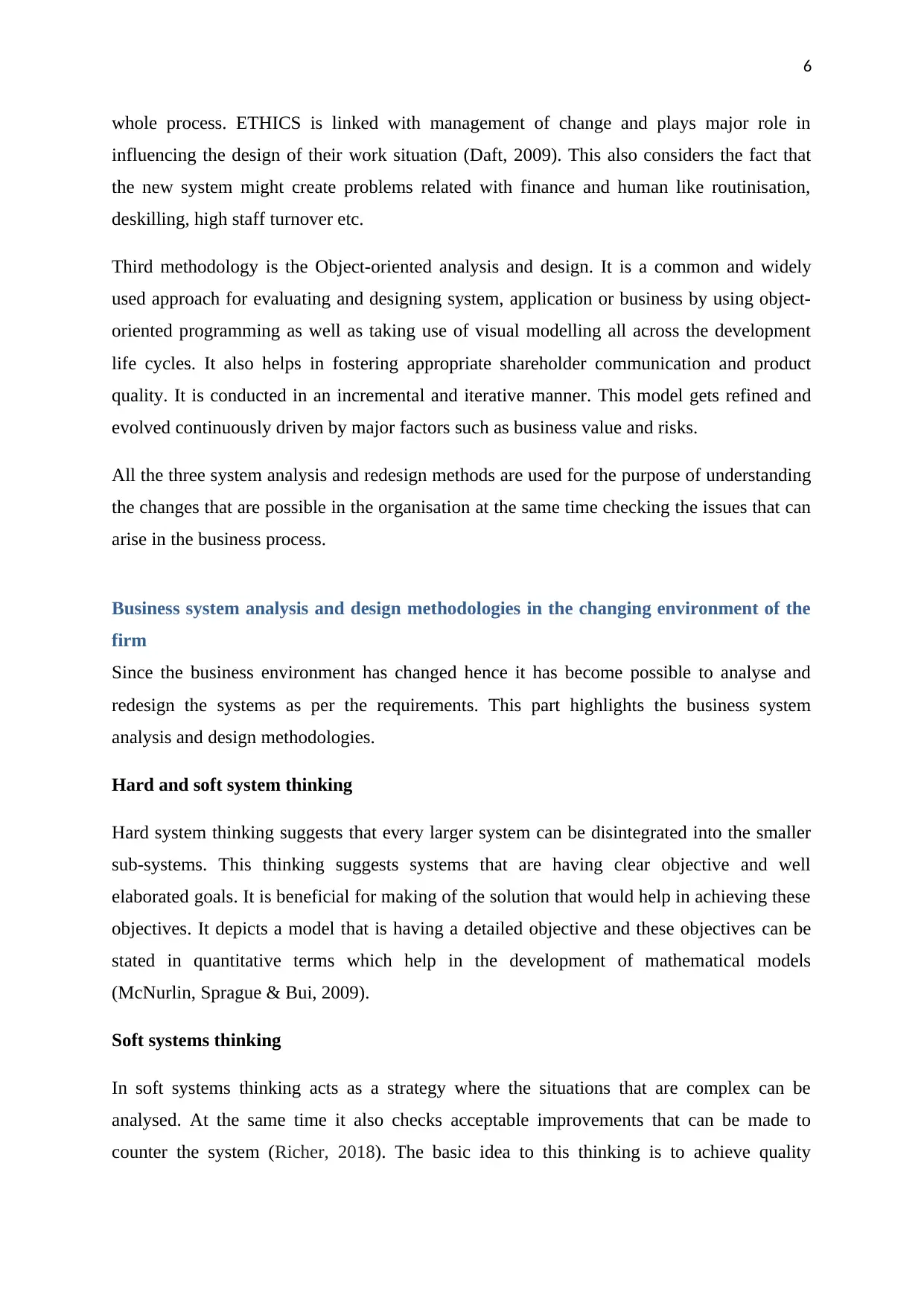
6
whole process. ETHICS is linked with management of change and plays major role in
influencing the design of their work situation (Daft, 2009). This also considers the fact that
the new system might create problems related with finance and human like routinisation,
deskilling, high staff turnover etc.
Third methodology is the Object-oriented analysis and design. It is a common and widely
used approach for evaluating and designing system, application or business by using object-
oriented programming as well as taking use of visual modelling all across the development
life cycles. It also helps in fostering appropriate shareholder communication and product
quality. It is conducted in an incremental and iterative manner. This model gets refined and
evolved continuously driven by major factors such as business value and risks.
All the three system analysis and redesign methods are used for the purpose of understanding
the changes that are possible in the organisation at the same time checking the issues that can
arise in the business process.
Business system analysis and design methodologies in the changing environment of the
firm
Since the business environment has changed hence it has become possible to analyse and
redesign the systems as per the requirements. This part highlights the business system
analysis and design methodologies.
Hard and soft system thinking
Hard system thinking suggests that every larger system can be disintegrated into the smaller
sub-systems. This thinking suggests systems that are having clear objective and well
elaborated goals. It is beneficial for making of the solution that would help in achieving these
objectives. It depicts a model that is having a detailed objective and these objectives can be
stated in quantitative terms which help in the development of mathematical models
(McNurlin, Sprague & Bui, 2009).
Soft systems thinking
In soft systems thinking acts as a strategy where the situations that are complex can be
analysed. At the same time it also checks acceptable improvements that can be made to
counter the system (Richer, 2018). The basic idea to this thinking is to achieve quality
whole process. ETHICS is linked with management of change and plays major role in
influencing the design of their work situation (Daft, 2009). This also considers the fact that
the new system might create problems related with finance and human like routinisation,
deskilling, high staff turnover etc.
Third methodology is the Object-oriented analysis and design. It is a common and widely
used approach for evaluating and designing system, application or business by using object-
oriented programming as well as taking use of visual modelling all across the development
life cycles. It also helps in fostering appropriate shareholder communication and product
quality. It is conducted in an incremental and iterative manner. This model gets refined and
evolved continuously driven by major factors such as business value and risks.
All the three system analysis and redesign methods are used for the purpose of understanding
the changes that are possible in the organisation at the same time checking the issues that can
arise in the business process.
Business system analysis and design methodologies in the changing environment of the
firm
Since the business environment has changed hence it has become possible to analyse and
redesign the systems as per the requirements. This part highlights the business system
analysis and design methodologies.
Hard and soft system thinking
Hard system thinking suggests that every larger system can be disintegrated into the smaller
sub-systems. This thinking suggests systems that are having clear objective and well
elaborated goals. It is beneficial for making of the solution that would help in achieving these
objectives. It depicts a model that is having a detailed objective and these objectives can be
stated in quantitative terms which help in the development of mathematical models
(McNurlin, Sprague & Bui, 2009).
Soft systems thinking
In soft systems thinking acts as a strategy where the situations that are complex can be
analysed. At the same time it also checks acceptable improvements that can be made to
counter the system (Richer, 2018). The basic idea to this thinking is to achieve quality
Paraphrase This Document
Need a fresh take? Get an instant paraphrase of this document with our AI Paraphraser
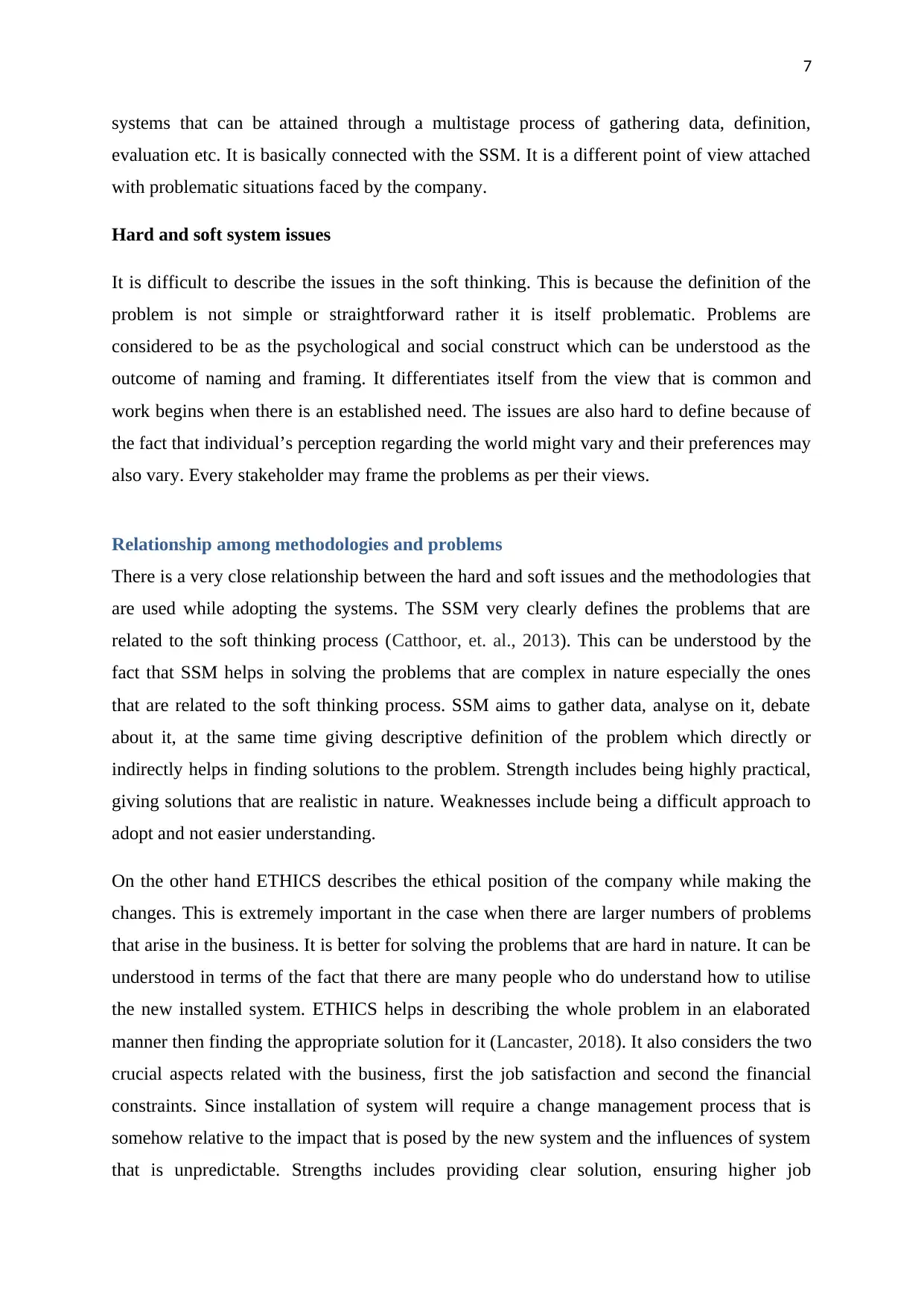
7
systems that can be attained through a multistage process of gathering data, definition,
evaluation etc. It is basically connected with the SSM. It is a different point of view attached
with problematic situations faced by the company.
Hard and soft system issues
It is difficult to describe the issues in the soft thinking. This is because the definition of the
problem is not simple or straightforward rather it is itself problematic. Problems are
considered to be as the psychological and social construct which can be understood as the
outcome of naming and framing. It differentiates itself from the view that is common and
work begins when there is an established need. The issues are also hard to define because of
the fact that individual’s perception regarding the world might vary and their preferences may
also vary. Every stakeholder may frame the problems as per their views.
Relationship among methodologies and problems
There is a very close relationship between the hard and soft issues and the methodologies that
are used while adopting the systems. The SSM very clearly defines the problems that are
related to the soft thinking process (Catthoor, et. al., 2013). This can be understood by the
fact that SSM helps in solving the problems that are complex in nature especially the ones
that are related to the soft thinking process. SSM aims to gather data, analyse on it, debate
about it, at the same time giving descriptive definition of the problem which directly or
indirectly helps in finding solutions to the problem. Strength includes being highly practical,
giving solutions that are realistic in nature. Weaknesses include being a difficult approach to
adopt and not easier understanding.
On the other hand ETHICS describes the ethical position of the company while making the
changes. This is extremely important in the case when there are larger numbers of problems
that arise in the business. It is better for solving the problems that are hard in nature. It can be
understood in terms of the fact that there are many people who do understand how to utilise
the new installed system. ETHICS helps in describing the whole problem in an elaborated
manner then finding the appropriate solution for it (Lancaster, 2018). It also considers the two
crucial aspects related with the business, first the job satisfaction and second the financial
constraints. Since installation of system will require a change management process that is
somehow relative to the impact that is posed by the new system and the influences of system
that is unpredictable. Strengths includes providing clear solution, ensuring higher job
systems that can be attained through a multistage process of gathering data, definition,
evaluation etc. It is basically connected with the SSM. It is a different point of view attached
with problematic situations faced by the company.
Hard and soft system issues
It is difficult to describe the issues in the soft thinking. This is because the definition of the
problem is not simple or straightforward rather it is itself problematic. Problems are
considered to be as the psychological and social construct which can be understood as the
outcome of naming and framing. It differentiates itself from the view that is common and
work begins when there is an established need. The issues are also hard to define because of
the fact that individual’s perception regarding the world might vary and their preferences may
also vary. Every stakeholder may frame the problems as per their views.
Relationship among methodologies and problems
There is a very close relationship between the hard and soft issues and the methodologies that
are used while adopting the systems. The SSM very clearly defines the problems that are
related to the soft thinking process (Catthoor, et. al., 2013). This can be understood by the
fact that SSM helps in solving the problems that are complex in nature especially the ones
that are related to the soft thinking process. SSM aims to gather data, analyse on it, debate
about it, at the same time giving descriptive definition of the problem which directly or
indirectly helps in finding solutions to the problem. Strength includes being highly practical,
giving solutions that are realistic in nature. Weaknesses include being a difficult approach to
adopt and not easier understanding.
On the other hand ETHICS describes the ethical position of the company while making the
changes. This is extremely important in the case when there are larger numbers of problems
that arise in the business. It is better for solving the problems that are hard in nature. It can be
understood in terms of the fact that there are many people who do understand how to utilise
the new installed system. ETHICS helps in describing the whole problem in an elaborated
manner then finding the appropriate solution for it (Lancaster, 2018). It also considers the two
crucial aspects related with the business, first the job satisfaction and second the financial
constraints. Since installation of system will require a change management process that is
somehow relative to the impact that is posed by the new system and the influences of system
that is unpredictable. Strengths includes providing clear solution, ensuring higher job
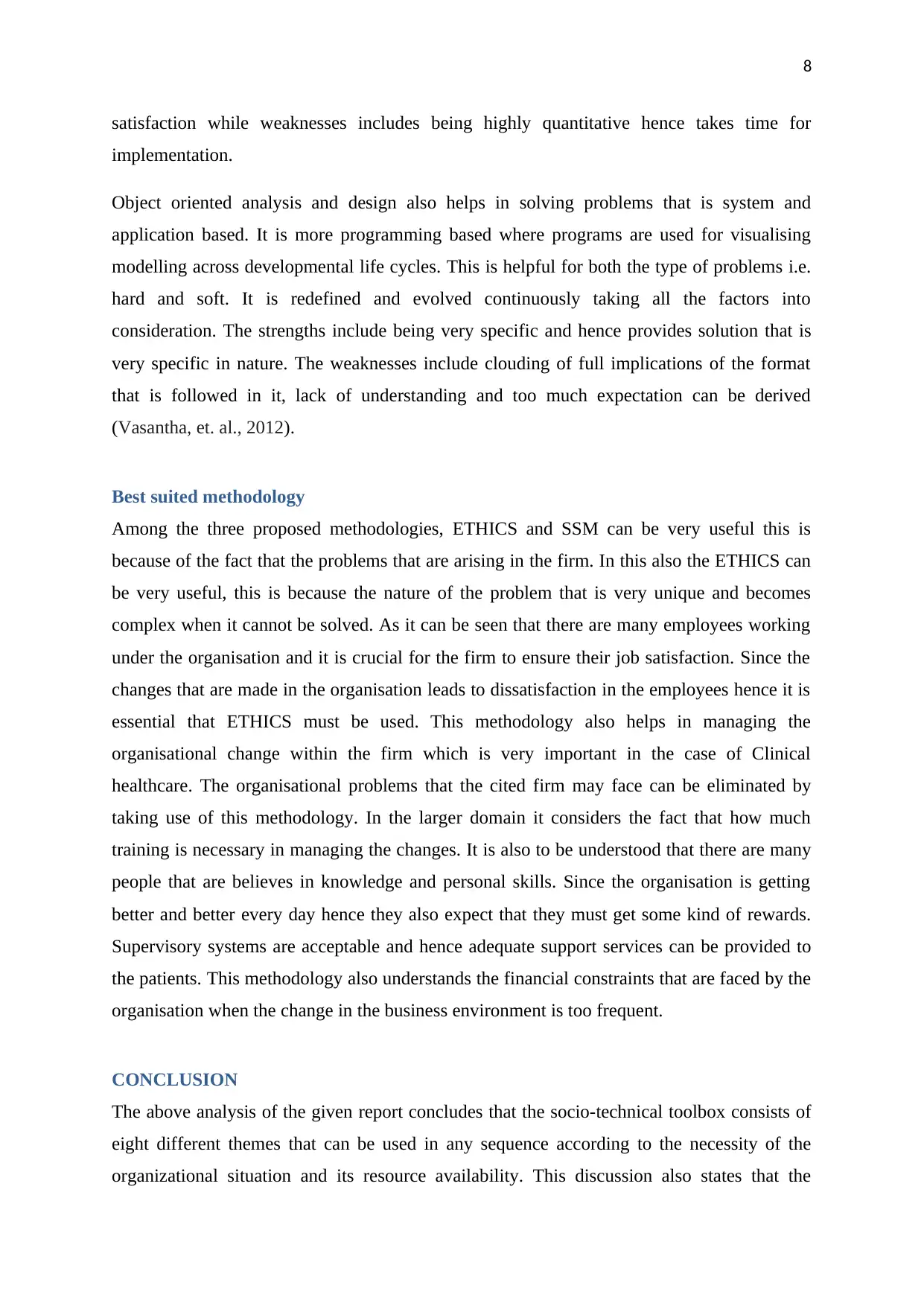
8
satisfaction while weaknesses includes being highly quantitative hence takes time for
implementation.
Object oriented analysis and design also helps in solving problems that is system and
application based. It is more programming based where programs are used for visualising
modelling across developmental life cycles. This is helpful for both the type of problems i.e.
hard and soft. It is redefined and evolved continuously taking all the factors into
consideration. The strengths include being very specific and hence provides solution that is
very specific in nature. The weaknesses include clouding of full implications of the format
that is followed in it, lack of understanding and too much expectation can be derived
(Vasantha, et. al., 2012).
Best suited methodology
Among the three proposed methodologies, ETHICS and SSM can be very useful this is
because of the fact that the problems that are arising in the firm. In this also the ETHICS can
be very useful, this is because the nature of the problem that is very unique and becomes
complex when it cannot be solved. As it can be seen that there are many employees working
under the organisation and it is crucial for the firm to ensure their job satisfaction. Since the
changes that are made in the organisation leads to dissatisfaction in the employees hence it is
essential that ETHICS must be used. This methodology also helps in managing the
organisational change within the firm which is very important in the case of Clinical
healthcare. The organisational problems that the cited firm may face can be eliminated by
taking use of this methodology. In the larger domain it considers the fact that how much
training is necessary in managing the changes. It is also to be understood that there are many
people that are believes in knowledge and personal skills. Since the organisation is getting
better and better every day hence they also expect that they must get some kind of rewards.
Supervisory systems are acceptable and hence adequate support services can be provided to
the patients. This methodology also understands the financial constraints that are faced by the
organisation when the change in the business environment is too frequent.
CONCLUSION
The above analysis of the given report concludes that the socio-technical toolbox consists of
eight different themes that can be used in any sequence according to the necessity of the
organizational situation and its resource availability. This discussion also states that the
satisfaction while weaknesses includes being highly quantitative hence takes time for
implementation.
Object oriented analysis and design also helps in solving problems that is system and
application based. It is more programming based where programs are used for visualising
modelling across developmental life cycles. This is helpful for both the type of problems i.e.
hard and soft. It is redefined and evolved continuously taking all the factors into
consideration. The strengths include being very specific and hence provides solution that is
very specific in nature. The weaknesses include clouding of full implications of the format
that is followed in it, lack of understanding and too much expectation can be derived
(Vasantha, et. al., 2012).
Best suited methodology
Among the three proposed methodologies, ETHICS and SSM can be very useful this is
because of the fact that the problems that are arising in the firm. In this also the ETHICS can
be very useful, this is because the nature of the problem that is very unique and becomes
complex when it cannot be solved. As it can be seen that there are many employees working
under the organisation and it is crucial for the firm to ensure their job satisfaction. Since the
changes that are made in the organisation leads to dissatisfaction in the employees hence it is
essential that ETHICS must be used. This methodology also helps in managing the
organisational change within the firm which is very important in the case of Clinical
healthcare. The organisational problems that the cited firm may face can be eliminated by
taking use of this methodology. In the larger domain it considers the fact that how much
training is necessary in managing the changes. It is also to be understood that there are many
people that are believes in knowledge and personal skills. Since the organisation is getting
better and better every day hence they also expect that they must get some kind of rewards.
Supervisory systems are acceptable and hence adequate support services can be provided to
the patients. This methodology also understands the financial constraints that are faced by the
organisation when the change in the business environment is too frequent.
CONCLUSION
The above analysis of the given report concludes that the socio-technical toolbox consists of
eight different themes that can be used in any sequence according to the necessity of the
organizational situation and its resource availability. This discussion also states that the
⊘ This is a preview!⊘
Do you want full access?
Subscribe today to unlock all pages.

Trusted by 1+ million students worldwide
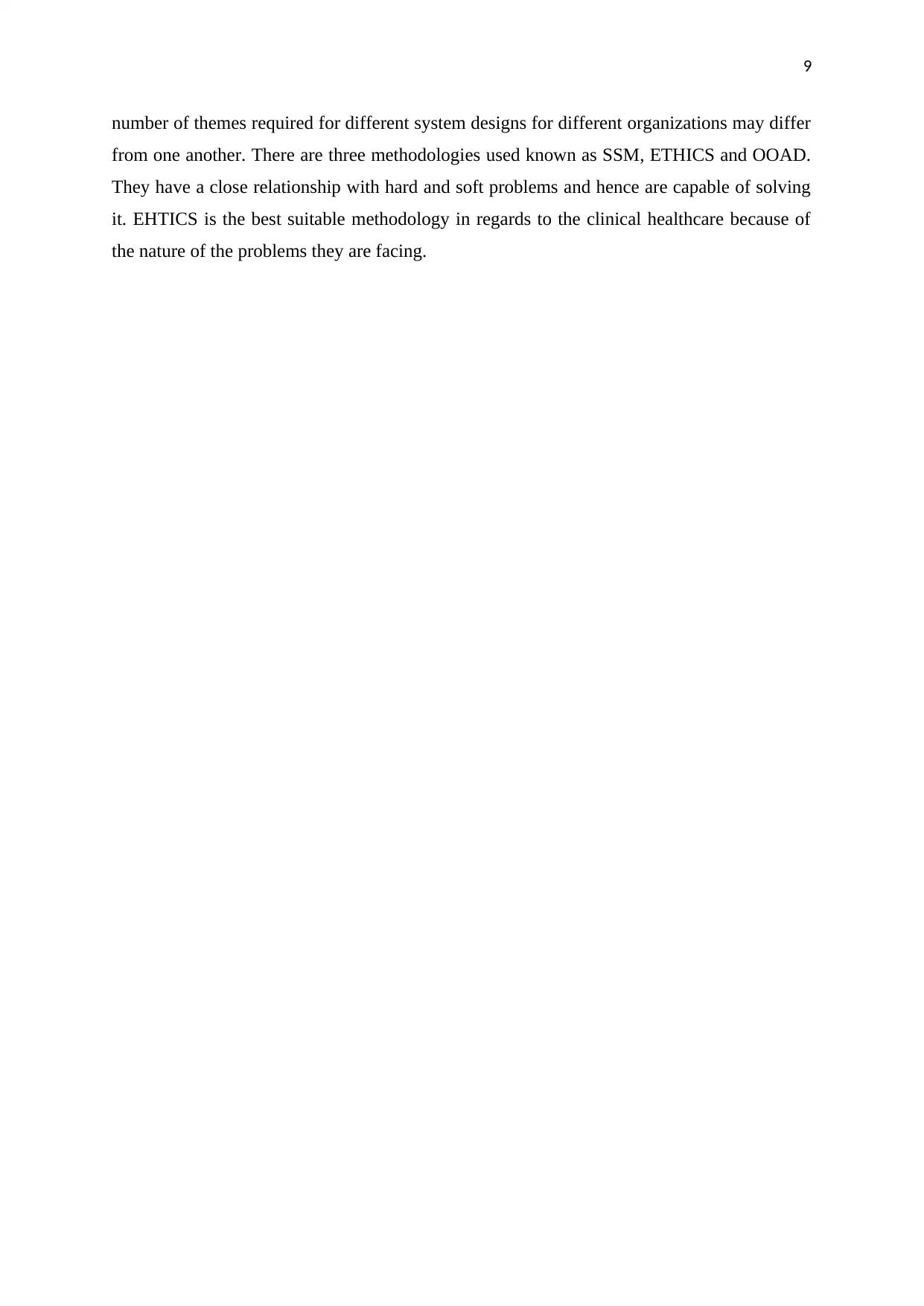
9
number of themes required for different system designs for different organizations may differ
from one another. There are three methodologies used known as SSM, ETHICS and OOAD.
They have a close relationship with hard and soft problems and hence are capable of solving
it. EHTICS is the best suitable methodology in regards to the clinical healthcare because of
the nature of the problems they are facing.
number of themes required for different system designs for different organizations may differ
from one another. There are three methodologies used known as SSM, ETHICS and OOAD.
They have a close relationship with hard and soft problems and hence are capable of solving
it. EHTICS is the best suitable methodology in regards to the clinical healthcare because of
the nature of the problems they are facing.
Paraphrase This Document
Need a fresh take? Get an instant paraphrase of this document with our AI Paraphraser
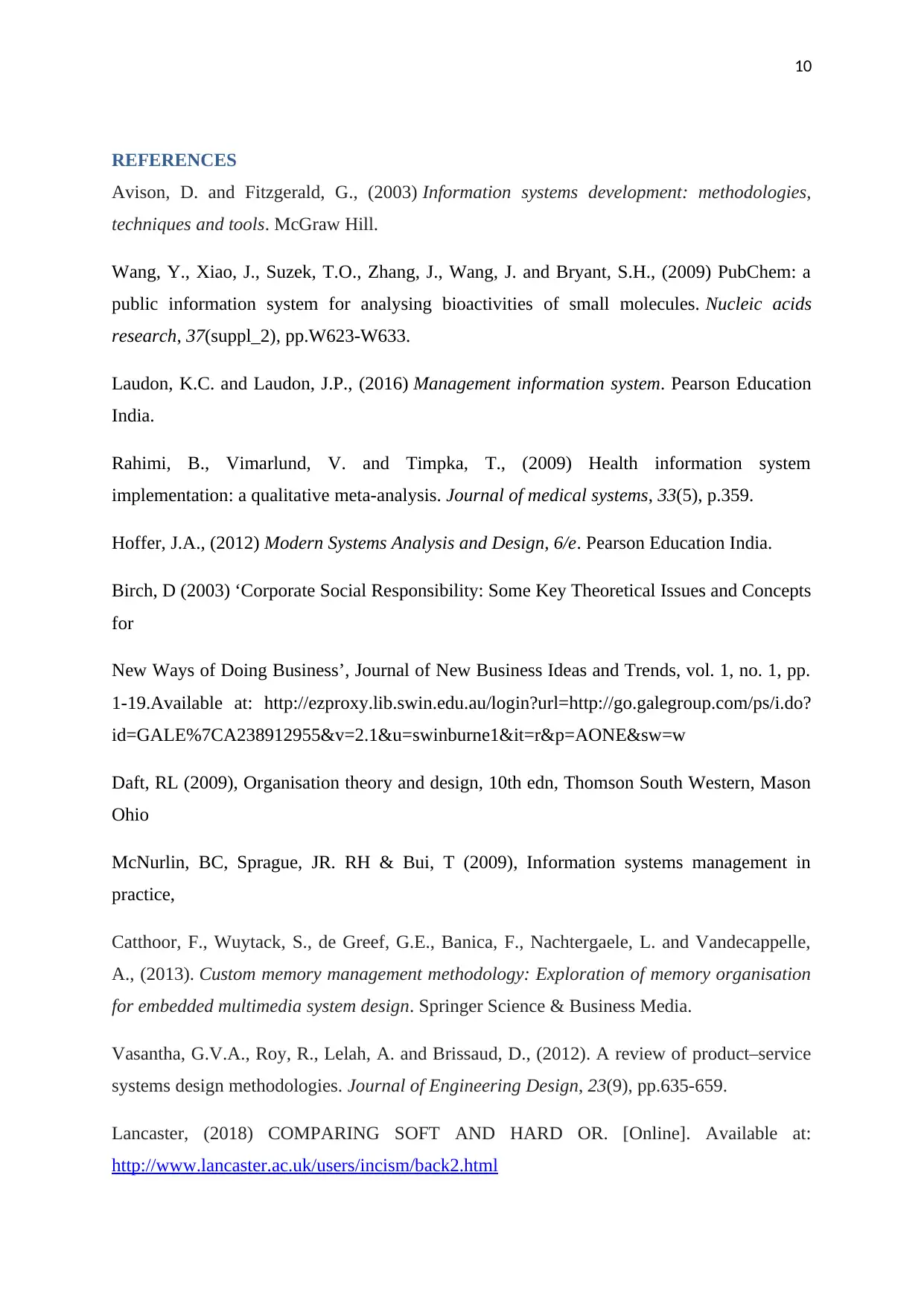
10
REFERENCES
Avison, D. and Fitzgerald, G., (2003) Information systems development: methodologies,
techniques and tools. McGraw Hill.
Wang, Y., Xiao, J., Suzek, T.O., Zhang, J., Wang, J. and Bryant, S.H., (2009) PubChem: a
public information system for analysing bioactivities of small molecules. Nucleic acids
research, 37(suppl_2), pp.W623-W633.
Laudon, K.C. and Laudon, J.P., (2016) Management information system. Pearson Education
India.
Rahimi, B., Vimarlund, V. and Timpka, T., (2009) Health information system
implementation: a qualitative meta-analysis. Journal of medical systems, 33(5), p.359.
Hoffer, J.A., (2012) Modern Systems Analysis and Design, 6/e. Pearson Education India.
Birch, D (2003) ‘Corporate Social Responsibility: Some Key Theoretical Issues and Concepts
for
New Ways of Doing Business’, Journal of New Business Ideas and Trends, vol. 1, no. 1, pp.
1-19.Available at: http://ezproxy.lib.swin.edu.au/login?url=http://go.galegroup.com/ps/i.do?
id=GALE%7CA238912955&v=2.1&u=swinburne1&it=r&p=AONE&sw=w
Daft, RL (2009), Organisation theory and design, 10th edn, Thomson South Western, Mason
Ohio
McNurlin, BC, Sprague, JR. RH & Bui, T (2009), Information systems management in
practice,
Catthoor, F., Wuytack, S., de Greef, G.E., Banica, F., Nachtergaele, L. and Vandecappelle,
A., (2013). Custom memory management methodology: Exploration of memory organisation
for embedded multimedia system design. Springer Science & Business Media.
Vasantha, G.V.A., Roy, R., Lelah, A. and Brissaud, D., (2012). A review of product–service
systems design methodologies. Journal of Engineering Design, 23(9), pp.635-659.
Lancaster, (2018) COMPARING SOFT AND HARD OR. [Online]. Available at:
http://www.lancaster.ac.uk/users/incism/back2.html
REFERENCES
Avison, D. and Fitzgerald, G., (2003) Information systems development: methodologies,
techniques and tools. McGraw Hill.
Wang, Y., Xiao, J., Suzek, T.O., Zhang, J., Wang, J. and Bryant, S.H., (2009) PubChem: a
public information system for analysing bioactivities of small molecules. Nucleic acids
research, 37(suppl_2), pp.W623-W633.
Laudon, K.C. and Laudon, J.P., (2016) Management information system. Pearson Education
India.
Rahimi, B., Vimarlund, V. and Timpka, T., (2009) Health information system
implementation: a qualitative meta-analysis. Journal of medical systems, 33(5), p.359.
Hoffer, J.A., (2012) Modern Systems Analysis and Design, 6/e. Pearson Education India.
Birch, D (2003) ‘Corporate Social Responsibility: Some Key Theoretical Issues and Concepts
for
New Ways of Doing Business’, Journal of New Business Ideas and Trends, vol. 1, no. 1, pp.
1-19.Available at: http://ezproxy.lib.swin.edu.au/login?url=http://go.galegroup.com/ps/i.do?
id=GALE%7CA238912955&v=2.1&u=swinburne1&it=r&p=AONE&sw=w
Daft, RL (2009), Organisation theory and design, 10th edn, Thomson South Western, Mason
Ohio
McNurlin, BC, Sprague, JR. RH & Bui, T (2009), Information systems management in
practice,
Catthoor, F., Wuytack, S., de Greef, G.E., Banica, F., Nachtergaele, L. and Vandecappelle,
A., (2013). Custom memory management methodology: Exploration of memory organisation
for embedded multimedia system design. Springer Science & Business Media.
Vasantha, G.V.A., Roy, R., Lelah, A. and Brissaud, D., (2012). A review of product–service
systems design methodologies. Journal of Engineering Design, 23(9), pp.635-659.
Lancaster, (2018) COMPARING SOFT AND HARD OR. [Online]. Available at:
http://www.lancaster.ac.uk/users/incism/back2.html
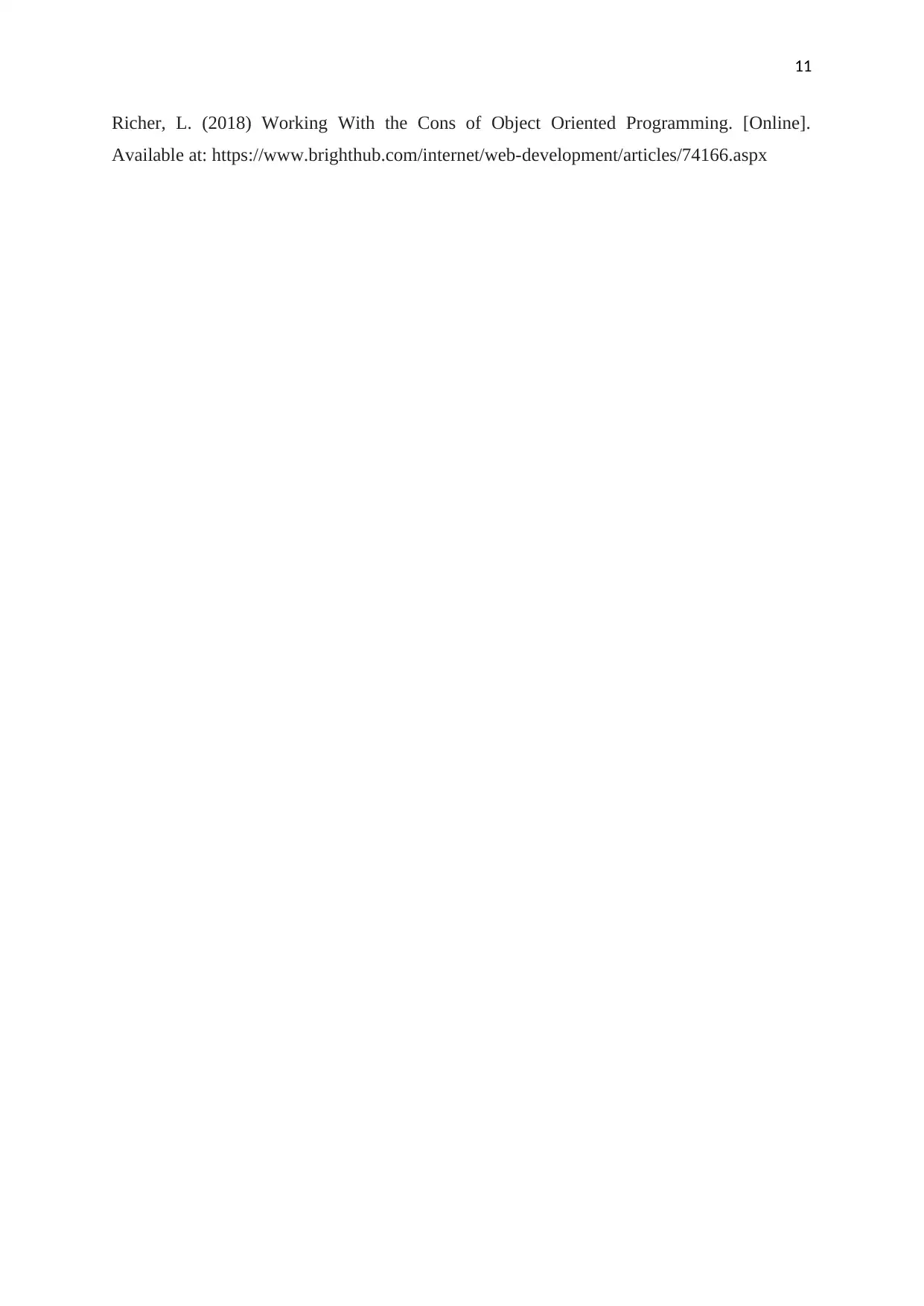
11
Richer, L. (2018) Working With the Cons of Object Oriented Programming. [Online].
Available at: https://www.brighthub.com/internet/web-development/articles/74166.aspx
Richer, L. (2018) Working With the Cons of Object Oriented Programming. [Online].
Available at: https://www.brighthub.com/internet/web-development/articles/74166.aspx
⊘ This is a preview!⊘
Do you want full access?
Subscribe today to unlock all pages.

Trusted by 1+ million students worldwide
1 out of 12
Related Documents
Your All-in-One AI-Powered Toolkit for Academic Success.
+13062052269
info@desklib.com
Available 24*7 on WhatsApp / Email
![[object Object]](/_next/static/media/star-bottom.7253800d.svg)
Unlock your academic potential
Copyright © 2020–2025 A2Z Services. All Rights Reserved. Developed and managed by ZUCOL.


